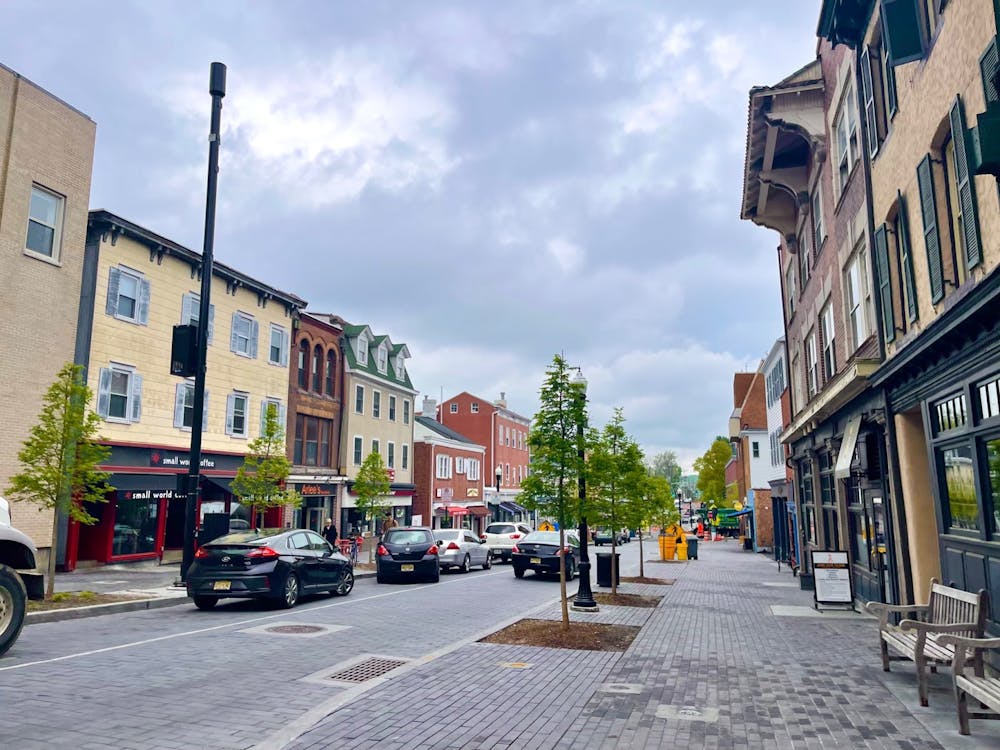Responding to recent town contention around traffic and parking, Princeton’s town council passed an ordinance eliminating free, temporary parking on a section of Witherspoon Street at a Dec. 11 meeting. Council members and community members also discussed the Franklin Maple project, a proposed affordable housing development that would bring the town closer to compliance with its 2020 mandate to build 753 affordable housing units by 2025.
The elimination of free parking on Witherspoon Street
There will no longer be free parking for loading on Witherspoon Street between Nassau Street and Wiggins Street, per a new town ordinance. Previously, free three-minute loading spaces from 6 a.m. to 10 a.m. in the service lane and free 30 minute loading spaces after 10 a.m. allowed visitors to stop by quickly for purchases and deliveries at businesses.
That portion of the street is home to a number of restaurants that students frequent, including Small World Coffee, Olives, and Jules Thin Crust. It has recently been under major construction with the intention of shifting the street to better serve pedestrians. In a February email to the ‘Prince,’ Town Councilman David Cohen described the construction projects as “rebalancing our public rights of way to serve all users — not just drivers, but also pedestrians, cyclists, transit users, and customers of adjacent businesses.”
Cohen wrote that the elimination of free parking was “an important change,” citing issues with the way free parking was being used. The current three minute limit is “virtually impossible to enforce,” according to Cohen, and “drivers have really abused it, filling all the loading spaces that are supposed to be for delivery and garbage trucks up until 10 a.m., causing those vehicles to stop in the traffic lane and totally block traffic.” Based on feedback, the council is establishing a 90 minute paid parking time period in the service lane from 6 a.m.–10 a.m.
No one present at the meeting expressed opposition to the ordinance, with one public comment commending the collaboration of businesses and community members on this decision.
A resolution, “Opposing the Expansion of the New Jersey I-95 Turnpike,” was also passed, with council members highlighting the costly burden of the $6.2 billion project and citing evidence that road expansion is not always effective at reducing traffic. The money should instead be put towards NJ Transit, the opposition claimed, especially if municipalities aim to decrease reliance on cars. The widening, proposed by the New Jersey Turnpike Authority, has also come under fire by environmentalists who oppose the major construction process. The Princeton Town Council has no direct oversight over the project.
A debate on affordable housing

More contentious were two resolutions regarding an affordable housing proposal on Franklin Avenue and Maple Terrace, presented by affordable housing attorney Kevin Van Hise.
Affordable housing has been the most significant flashpoint in town politics in recent years, after an affordable housing ordinance proposed new units in town. Some community members have campaigned against specific projects, such as one in an area in the Jugtown Historic District.
Van Hise explained these resolutions are formalities needed to move forward with an agreement between the developer, the municipality, and the Princeton Housing Authority to build a total of 160 units, with 80 at affordable rate and 80 as “workforce housing.” Workforce housing is most commonly intended for households with incomes between 80 and 120 percent of median income of the metropolitan area, meant to address the “missing middle” often referred to in housing discussion.
Princeton Planning Board is currently receiving applications and approving construction by developers for affordable housing developments, two years after a 2020 mandate that aims to significantly increase affordable housing in the municipality. The plan sets a goal of constructing 753 new affordable housing units by 2025.

Some present at the meeting expressed concern with the lack of community input and issues of clarity in the resolution's language and timeline.
One community member explained that it is “good news we are honoring affordable housing,” but raised a number of questions about the project, including what happens if the 10 year timeline fails, how pilot money would be directed, and for what purpose. Another community member echoed confusion on whether the ordinance enforces “workforce housing” or “market rate” housing, and suggested the ordinance be “more specific” when Van Hise answered the ordinance refers to the former.
A third community member said she was “disappointed and disheartened” that there has been no communication with this neighborhood about the development of the lot. Garoniak mentioned a petition signed by hundreds citing a concern with density. The ‘Prince’ was unable to obtain a copy of the petition.
In response, Councilmember Mia Sacks criticized the level of scrutiny, explaining that the goal of the ordinance is to signify compliance with the municipality’s court-mandated affordable housing requirement, not to hash out details. She emphasized the municipality’s long overdue commitment to their obligation, and that the individual answering these questions, the developer, was not present at the meeting.
Abby Leibowitz is a senior News writer for the ‘Prince.’
Please send any corrections to corrections[at]dailyprincetonian.com








